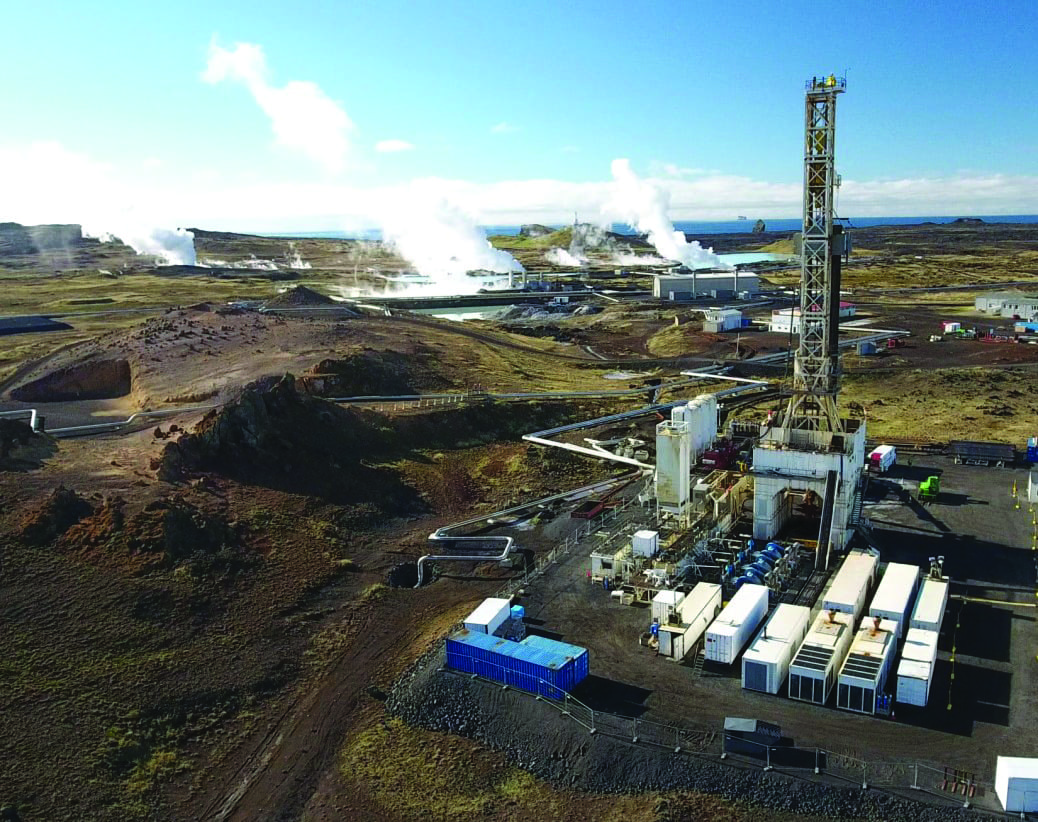Geothermal Drilling in Iceland Reaches Supercritical Target
A unique collaborative effort by a consortium of Icelandic power companies and the Icelandic government to determine whether using supercritical geothermal fluids would improve the economics of power production from geothermal fields reached an unprecedented milestone at the end of January: After drilling for 168 days, a team reached a depth of 4,659 meters—deep enough to reach supercritical conditions.
When it first got its start around 2003, the Iceland Deep Drilling Project (IDDP) was armed with only a feasibility study suggesting that compared to relative output from conventional geothermal wells (which are about 2.5 kilometers [km] deep), the use of fluid produced from reservoirs hotter than 450C could increase power output tenfold. In 2009, the first borehole in a series of wells in Krafla, northeast Iceland—a project dubbed “IDDP-1”—unexpectedly penetrated into magma of between 900C and 1,000C, at a depth of only 2,100 meters (m). It was only the second time anyone in the world had drilled into magma—the first instance was in Hawaii in 2007—and the IDDP was elated by its achievement.
The IDDP—which includes HS Orka, Reykjavik Energy, Iceland’s National Power Co., and the National Energy Authority of Iceland—pumped cold water into the hole to fracture rock near the magma and create high permeability. Eventually, high-pressure steam at temperatures of more than 450C, a measured output that was sufficient for 35 MWe, was allowed to flow out of the hole for two years. IDDP-1 was widely lauded because it represented a unique engineered geothermal system that was the world’s first to supply heat directly from molten magma (for more, see “Developing the World’s First Magma-Enhanced Geothermal System” in POWER’s March 2014 issue).
In July 2012, however, repair of surface installations became unavoidable, and the well had to be quenched owing to the failure of master valves. According to the IDDP, this ultimately caused the collapse of the well casing. But while IDDP abandoned that project, the Krafla project isn’t entirely dead. This March, more than 30 magma and geothermal scientists from 11 countries convened for a three-day meeting in Paris to work out plans for the new $100 million Krafla Magma Testbed project, which could ultimately see another 2.1-km-deep hole drilled into the magma chamber. And this June, the International Continental Scientific Drilling Programme plans to pour in $5.5 million to kick start the project, which it says could present a prime opportunity to investigate magma properties in-situ.
The IDDP, meanwhile, has switched gears and pushed on with its own mission, choosing to explore Reykjanes (Figure 2) near the southern tip of the Reykjanes Peninsula, the second of three geothermal fields it had initially deemed suitable in its search for supercritical resources (the third is Hellisheidi in southwest Iceland). HS Orka, a power generator that operates and sells power from the 75-MW Svartsengi and 100-MW Reykjanesvirkjun goethermal power plants, led drilling at Reykjanes in close collaboration with IDDP partners Landsvirkjun, Orkuveita Reykjavíkur, the National Energy Authority, and Norwegian oil and gas firm Statoil.
HS Orka’s Reykjanesvirkjun geothermal plant sits in the Reykjanes geothermal field, which is a unique field among Icelandic geothermal systems because its reservoir fluid is modified seawater and it uses seawater to cool its steam condensers. IDDP-2 took advantage of an existing 2,500-m-deep production well for the plant and deepened it over several months to 4,659 m, though it was cased only to a depth of 3,000 m.
The team encountered a number of hurdles as drilling progressed, including weather delays and issues with hole stability that required frequent reaming. It was also forced to pause again and again as the drilling assembly got stuck several times. While those issues were ultimately resolved, the team’s biggest roadblock emerged when it completely lost circulation below 3,060 m. “As cementing was not successful, below 3180 m, drilling continued without any return of drill cuttings to the surface,” IDDP said.
On January 25, it reached its record depth of 4,659 m, and IDDP declared that “all initial targets were reached.” Its goals, it said, were to drill deep to extract drill cores, measure the temperature, and search for permeability. “The temperature at the bottom of the well has already been measured at 427C, with fluid pressure of 340 bars, drill cores were retrieved, and the rocks appear to be permeable at depth,” it added. “It’s clear that the bottom of the well reached fluids at supercritical conditions so that the main drilling phase objective of the project has been achieved.”
The consortium recognizes the vast implications of its achievement. “In [the] future, our demonstration that it is possible to drill into a supercritical zone could have a large impact on the economics of high-temperature geothermal resources worldwide,” it said. The project also suggests that development of supercritical geothermal resources could be possible in any young volcanic-hosted geothermal system worldwide, such as at Kakkonda in Japan, Larderello in Italy, Los Humeros in Mexico, and The Geysers and Salton Sea in the U.S.
“By extending the available economic reservoir downwards, we can extend the lifetimes of existing producing fields,” it added. Also, fewer turbines may be required for a given power output as higher enthalpy fluids have greater power conversion efficiencies. And, as fewer wells are needed for a given output, this could technically increase the productivity of a geothermal field without increasing its environmental footprint, it noted.
For now, at least, the IDDP will focus its efforts on the IDDP-3 project at Hellisheidi, where work is slated to begin in 2020, as soon as the IDDP secures funding.
—Sonal Patel is a POWER associate editor
